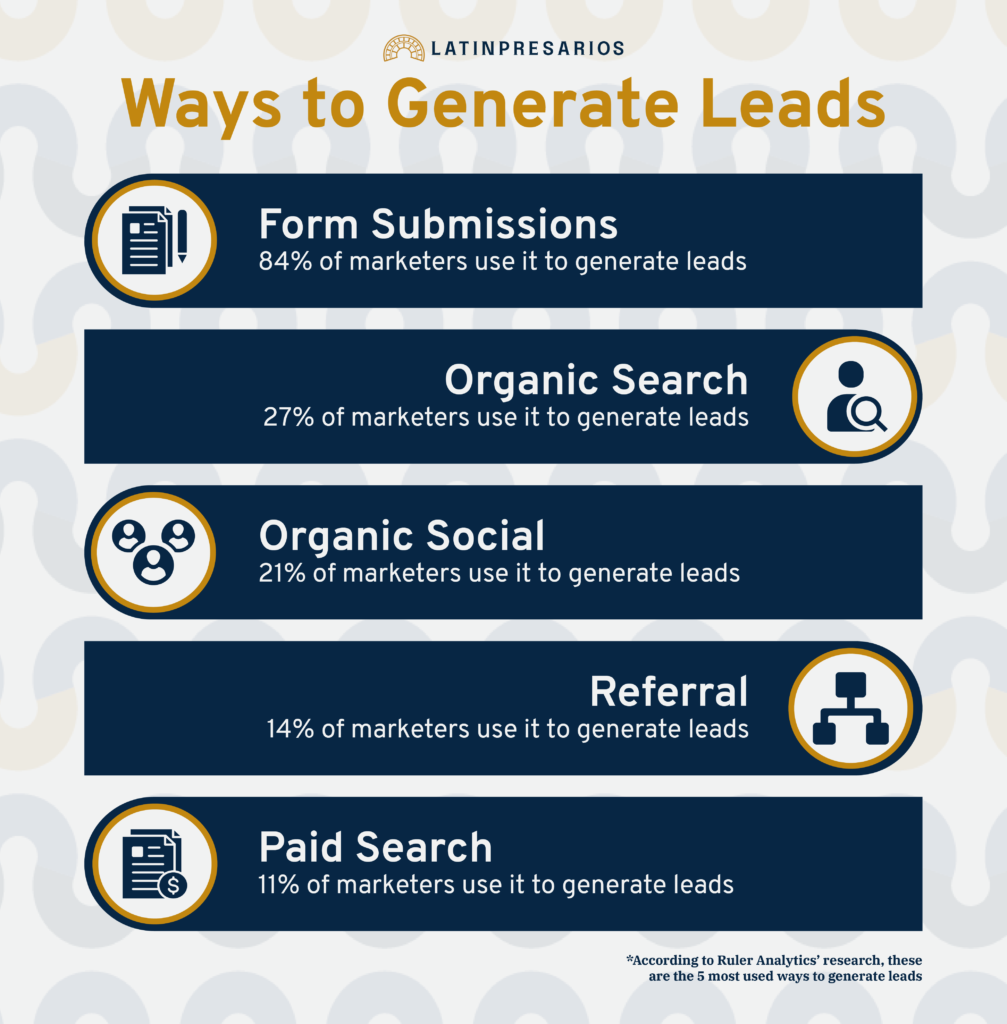In the digital marketing world, leads are a substantial part of the process of generating revenue for any business.
However, if you:
- Just founded your own business.
- Started developing your personal brand.
- Are getting to know this industry.
- And/or want to know how to get more clients through the internet, you must learn the lead generation meaning and how it can help you.
In order to know what lead generation is, we must first clarify what a lead is:
A lead is an individual who is interested in your business: in your products and/or services. They could potentially buy from you, but they aren’t there ‘quite yet’.
A lead is still unaware of your process and your products/services’ details. They don’t have the necessary information to make a buying decision, but they want to.
Before becoming a customer, a person must always first be a lead. And that’s one of the many reasons why lead generation is so important.
In fact, 91% of marketers say that lead generation is their most important goal (Source: Ruler Analytics).
But anyway, what is the lead generation meaning?
Lead generation, at first, is the process of attracting potential customers and letting them know about your business’ existence.
Nevertheless, it also consists of “increasing their interest through nurturing, all with the end goal of converting them into a customer” (Source: HubSpot).
In this article, you will find key aspects that will help you understand what lead generation is and why is it important to your digital development.
We’ll go through:
- Benefits of lead generation.
- Inbound & outbound lead generation.
- Ways to generate leads.
Keep in mind this is an introductory article: lead generation is a broad topic that covers a plethora of aspects.
You can learn more about digital marketing and personal branding at our learning center for thought leaders.
Contents
Benefits of Lead Generation
As we explained before, if you want to have customers, you must first get leads. That is the main benefit.
From this point of view, we could say that every business with clients already has a lead generation process.
However, we’re referring to the benefits of a conscious and intentional lead generation strategy.
Without further ado, these are the main benefits of lead generation:
Improves Your Content Marketing Strategy
A content marketing strategy is related to an inbound marketing strategy, as we will later see in this article.
In a few words, a great way to generate more leads is by producing valuable content that organically attracts people already interested in your products and/or services.
When you see your content production as an essential item in your lead generation process, you will naturally find ways to improve it.
Message Personalization
When you identify your leads in the digital world, you will probably have some key data on the prospect, such as:
- Gender.
- Age.
- Where do they live.
- Likes and dislikes.
- And much more.
All this information will help you personalize the messages you’re going to send them, and therefore, increase your chances of developing a connection with them.
It’s not the same trying to sell a car to a 20-year-old single male than selling it to a 50-year-old married woman, for example.
The more you know your prospect, the more opportunity you have to show them you can solve their problems.
Helps High-Involvement Purchases
Leads are important to any kind of business, regardless of the industry.
However, there are products and services that take longer to decide whether to buy or not.
It’s not the same to hire a pool-installing service as buying a keyboard on Amazon.
It’s not the same to buy a new phone as getting a burger.
Those buying decisions that involve more crucial aspects to consider are called “high involvement purchases”.
According to PocketSense, “A high involvement purchase exists when a consumer has to buy a product or service that is expensive or that possesses the risk of significant emotional consequences if a mistake is made”.
This directly affects the customer’s journey and how the company must handle a potential buyer.
If you work at a company or own a business that offers these types of purchases, then it’s a non-negotiable to work on your lead generation strategies.
Knowing your leads will allow you to optimize your pipeline and provide them with the information they need to make a well-informed decision.
Therefore, your prospects can trust you and buy from you more quickly.
If you do this correctly, you will shorten your customer’s journeys and close deals faster.
Revenue Growth
Marketo Engage has conducted research in which they discovered that companies with a careful lead generation strategy are able to increase their ROI by 133% versus other average companies.
This is because, by actively creating a lead generation process, you become more attractive to potential customers and therefore are able to close more deals.
Inbound vs. Outbound Lead Generation
As we are going to see later in this article, there are several ways to generate leads. However, they can be classified into two categories: inbound & outbound.
These terms are generally used to describe different marketing tactics, so you might hear them in other contexts apart from lead generation.
Inbound Lead Generation
Inbound marketing is all about creating and distributing content that organically attracts users to your website.
Once they are there, they should be able to get to know your products & services, learn about them, get interested and even make a purchase.
Inbound marketing is heavily related to content marketing, which focuses on producing valuable content that creates brand awareness.
In fact, “content marketing generates 3x as many leads as outbound marketing at less than half the cost”.
Nevertheless, inbound strategies take a lot of time to deliver results and it can be difficult to calculate their exact ROI.
Outbound Lead Generation
Outbound marketing is a more traditional approach than inbound. Outbound consists of reaching out to potential customers directly and, sometimes, abruptly.
Outbound marketing has become less common through the years since many people find it intrusive.
It also costs more money, because it requires paid media, and sometimes it doesn’t generate as much ROI long-term as other methodologies.
In fact, according to HubSpot, less than 25% of marketing professionals find outbound strategies to provide valuable leads.
However, if you know how to implement it, outbound marketing can give you results way faster than inbound.
This is because there are systems and apps that help you reach your ideal audience directly, instead of waiting for them to find you.
So, Inbound or Outbound?
It depends.
If you’re looking to build a strong brand and have the resources to invest in a strategy that will generate results over time, inbound is the right fit for you.
Inbound will allow you to create a brand that stands out and become a leader in your niche. Over time, it will also lower your acquisition costs and create more loyal customers.
On the other hand, if you want your business to grow quickly and need clients as soon as possible, outbound will most likely get you results in the periods you need.
It will, of course, also depend on your industry and specific case.
Ways to Generate Leads
There are many ways to generate leads.
Next, you will find the most used strategies. These are a combination of inbound and outbound activities.
However, there are many more possibilities, it’s all a matter of creativity!

Lead Generation Meaning & Use
Through this article, we have learned why lead generation is indispensable for your digital marketing strategy.
It will:
- Improve your content strategy.
- Allow you to personalize your copy.
- Offer high-involvement products.
- Grow revenue.
There are also many ways to do this, and there’s a perfect one for your brand.
Remember: many leads won’t mean many conversions. This is only a part of the process.
We know that getting new customers online is no easy task. That’s why we want to help you do it.
If you want to learn more about how to get clients, we have plenty of articles about it at our learning center.
Get ready to take the next step and become the thought leader in your niche!




